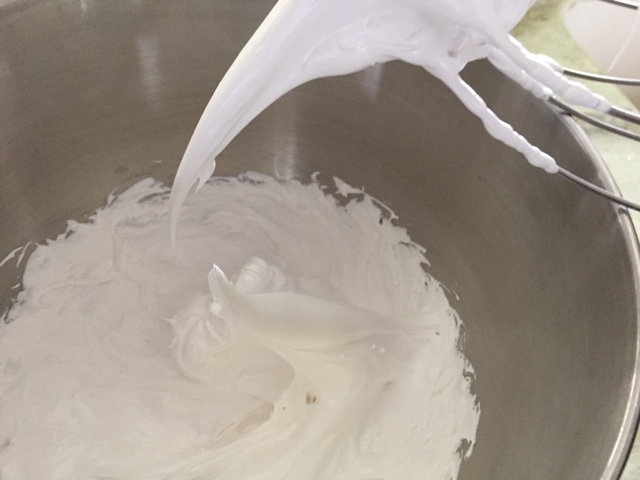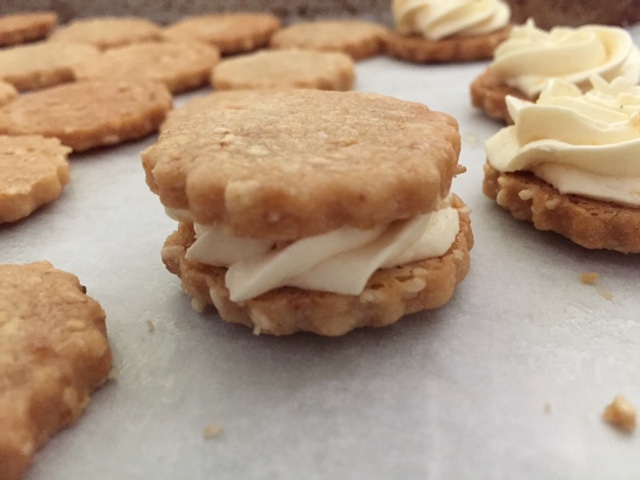A tasty trio for spring
/
A beautiful day at Fredrick Meijer Gardens here in Grand Rapids Michigan. Spring is here. Delightful.
And now on to the baking portion of the program.
While I was preparing some sweet treats for a recent L'Alliance Francaise de Grand Rapids event, I was reminded of those days working as the pastry chef at Gracie's in Providence RI where I often created dessert trios for special events or private dinners. I loved that. Three 2-bite experiences of different textures, creams, crunchies, fruits, nuts or what-have-you. No need to over do it - just some delicious little somethings to go with that after dinner coffee, tea or digestif - yes indeed.
For this menu I choose a petite apricot almond Breton cake topped with apricot caramel mascarpone cream and fresh raspberry, a delectable fudgy brownie with chocolate-graham-walnut crumble sprinkled over a ganache ribbon and my own sesame-cardamom shortbread cookie sandwiched with an orange honey buttercream.
In this case it's not about a specific recipe or technique but simply the imagination of putting different flavors and textures together. The more one bakes, the more one opens the mind to new ideas.
Interestingly, that's what I've found since teaching at Sur La Table here in Grand Rapids. The recipes are chosen by the corporation and tested in the SLT test kitchen before being put on a nationwide schedule that's offered to the public.
Lots of croissant and French macaron classes to be sure, but every month or two some new topics pop up like crepes, soufflés and British baking, all of which prompt me to review and refresh my own knowledge and expertise. It's all about learning! Plus I love figuring out what the problems might be when something doesn't turn out as expected. Keep trying!
So I've been doing things that haven't been in my typical scope of baking - Swiss meringue buttercream being one of them. Many of the macaron fillings for SLT classes are made using that technique with the flavors and fillings changing seasonally. I had previously not been a big fan of buttercreams, yet having now made a number of Swiss meringue versions I find them quite appealing.
There are many cake makers out there who do this in their sleep and many online resources presenting the process and all the delicious flavor variations that exist.
But just to review, a Swiss meringue is made by whisking egg whites and sugar over a bain marie to a temperature or 145º - 155ºF, then transferring it to a stand mixer and whipping to a nice glossy, stiff-peaked meringue. Voila!
The meringue should be cool before adding the butter a few pieces at a time. The result should be a smooth, creamy buttercream.
I my case I blended orange zest and honey into the buttercream, and it was oh so wonderful with the lightly honey glazed sesame cardamom shortbread. Yum yum yum.
Of course, let's not forget that there's a lot of butter involved so my "everything in moderation" approach still applies, but somehow the meringue and butter combo is quite lovely as a filling for a cookie sandwich or a swirl on the top of a petite cake.
As for the petite Breton cakes, I used a standard Breton dough recipe from Christophe Felder, placed pieces of dough into round flexi-molds, topped 'em with almond cream, a dollop of apricot jam and a sprinkling of brown sugar streusel.
After the bake, once cooled, I gave them a swirl of caramel mascarpone cream to which I had added some home made apricot purée, and topped 'em with a fresh raspberry.
The brownie bites were the recipe I've been making for Steve for some years, based on one from Fine Cooking magazine by Abigail Johnson way back when. I gave them a ganache ribbon topping and sprinkled my chocolate-graham crumb- walnut crumble mixture on top. Yup.
All were delicious, delightful and appreciated by L'Alliance Française guests.
The moral of the story? Use your imagination and keep creating your own flavorful treats! That's what it's all about.
Happy spring!






































